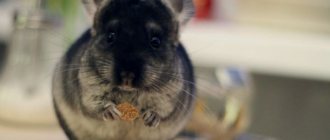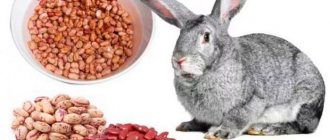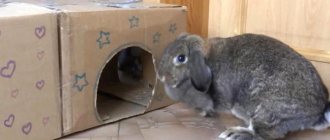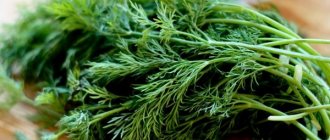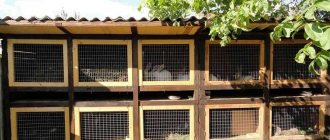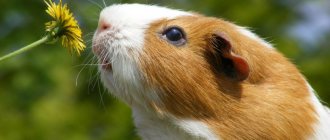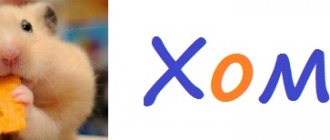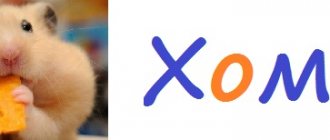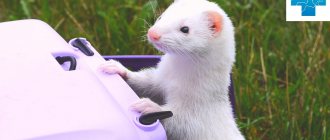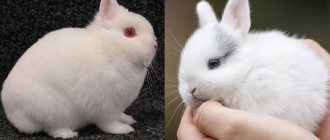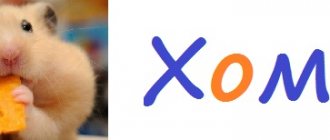Many people who want to have rabbits as pets are often faced with the question of what and how to feed them correctly. A special place is given to this issue when breeding dwarf rabbits. Their delicate digestive system is very sensitive to various fluctuations and reacts very negatively to improper diet.
To ensure that your pet rabbit is always healthy, you should pay a lot of attention to its feeding and read a number of recommendations. If you don’t follow the rules, you can easily lose your family’s furry “friend.”
Features of digestion of decorative rabbits
Food entering the rabbit's mouth is moistened with saliva from the salivary glands and chewed with the help of sharp teeth that are constantly growing. Next, the chewed lump of food is sent through the pharynx through the esophagus into the stomach.
The intestines of rabbits are small in size and have two sections - thin and thick. At the junction of the small intestine with the large intestine there is a “blind” reservoir, from which substances that suppress the development of colic and alkaline juice are released, which breaks down fiber and enhances the fermentation of food. Rabbit intestines have weak peristalsis, so it is important to monitor their diet and avoid food stagnation. Despite weak peristalsis, long-eared digestion is accelerated, so the animals eat constantly.
Considering the characteristics of the rabbit digestive tract, a number of conditions must be observed:
- do not let your eared starve;
- create a varied diet;
- give your pet solid food for cutting down teeth;
- To prevent constipation and loss of fluid in the body, animals should always have a drinking bowl with clean water.
Mineral stones
As mineral stones, you can use pieces of chalk, iodized salt, gypsum, as well as special granules that contain microelements necessary for the normal development of animals. The natural composition allows not only to grind down the incisors, but also strengthens the not particularly strong skeleton of these animals, and also helps improve digestion. Thus, abrasive properties are combined with benefits for the body.
For rabbits this is a welcome treat. To ensure that it is always available, mineral stones can be hung on the bars of the cage.
How many times a day should you feed a decorative rabbit and in what proportions?
The main diet of a decorative rabbit is hay (up to 48% of the total food). In addition to it, the pet’s body should receive daily:
- Proteins – up to 12%;
- Carbohydrates – up to 40%;
- Fats – up to 2%.
At home, the animal will be able to meet its nutritional needs by consuming granulated food, fruit and vegetable mixes, herbs, and grains.
The feeding schedule and frequency must be strictly observed, especially for pets under 1 year of age. The optimal feeding frequency is three times a day at the same time, but 2 meals a day are also possible (after a year).
Hay cannot be limited in the diet, but the dose of feed should be controlled. The animal should eat no more than 2 tbsp. l. combined food per meal, but not more than 2 times a day. Pregnant and lactating rabbits are fed up to 4 times a day, increasing their dose of succulent foods and the amount of hay.
| Approximate feeding scheme for a decorative rabbit | |
| 1. Morning | ½ daily serving of hay, 1 tbsp. l. dry food. |
| 2. Day | Daily portion of succulent feed. |
| 3. Evening | ½ daily portion of hay, dry or twig food. |
General nutrition information
Dwarf rabbits eat the same as their larger counterparts. Animals are strict vegans, that is, they eat only plant foods. In nature, they eat herbs and seeds, roots and twigs of shrubs, and fallen leaves. They do not disdain fruits, berries, and some root vegetables that have fallen from trees.
A rodent's teeth and entire digestive system are designed to process rough, fibrous plant foods. A lack of fiber in an animal's diet, if the emphasis is on concentrates, can lead to constipation and other health problems.
What can you feed a decorative rabbit?
A rational combination of different products makes it possible to establish proper nutrition for decorative rabbits.
The menu should include the following types of feed:
- Rough;
- Juicy;
- Grain, cereals;
- Compound feed;
- Vitamin and mineral premixes.
Roughage
Rough food - high-quality hay, twig food, wood - is the basis of the entire rabbit diet. The best hay is one made independently from meadow herbs. Good brooms of branches come from different deciduous trees.
Juicy natural food
Berries, a variety of greens, vegetables, and fruits are considered juicy. When introducing juicy foods, you need to monitor the reaction of the fluffies - for constipation or diarrhea. If there is any change in stool, the product that caused the negative reaction should be excluded from the diet. The amount of succulent food is adjusted according to the situation - taking into account age and digestive characteristics.
| What vegetables can you give? | Possible adverse reactions to consumption |
| Fodder varieties of carrots. | A universal vegetable for long-eared animals, a favorite treat, does not cause a reaction. |
| Beetroot, beet tops. | May cause digestive dysfunction. |
| Green cabbage (except red cabbage). | Causes frustration. |
| White cabbage. | Administer with caution after the main feeding to prevent bloating and diarrhea. |
| Green beans Green peas Cucumber and zucchini (without seeds) Pumpkin Tomatoes Turnips, radishes Potatoes Bell peppers (without seeds and white pulp) | Administer with caution after the main feeding to prevent bloating and diarrhea. |
Rabbits usually enjoy eating delicious fruits and dried fruits made from them. But such a delicacy can be introduced into the diet only closer to 4 months, and after having previously treated the animals for helminths.
| Fruits and berries | Features of the product and possible adverse reactions upon consumption |
| Apple Pear | Give every other day, after removing the seeds. |
| Watermelon melon | You can administer it in small portions without peels and seeds, observing the animal’s reaction. |
| Banana | Do not give to fat animals, the rest - 1 tbsp. l. for a day. |
| Mango | Remove the pit before adding to food. |
| Grape | Breastfeed only after a year, no more than a quarter glass per day; may cause diarrhea, bloating, and excess body weight. |
| Raisin | No more than 1 tbsp. l. dried fruits per day. |
| Mandarin | As a treat, 2 slices twice a week. |
Grain and cereals
The grain is well tolerated by the digestive tract of furry pets. And in the cold season, this type of product is considered the main energy source. The best choices for eared animals are barley, wheat, oats and corn.
Experienced breeders recommend mixing different types of grains, thus saturating the animal’s body with different nutrients and preventing the development of negative effects from monotony in food.
Cereals (millet, artek, oatmeal, rolled oats, pearl barley, barley) in a pet's menu should make up 2% of the main diet.
But flour products - bread and bakery products will be superfluous in the diet of rabbits. They contain a lot of starch and simple carbohydrates, which harm the body (cause poisoning, bloating, flatulence). It is allowed to give only crackers from the loaf in small quantities.
Greenery and tree branches
Decorative rabbits eat almost all herbs and greens. But before serving the plant, you need to wash and dry it. If you experience a runny nose or diarrhea from a certain type of green, it is better to avoid it. A mandatory element of nutrition is tree branches, which, in addition to their nutritional value, help rabbits sharpen their teeth. Wood and twigs from trees are given in unlimited quantities throughout the year. In case of vitamin deficiency, branches with swollen buds are considered beneficial.
| Healthy greens | Healthy branch food |
| Dandelions; Nettle; Alfalfa; Clover; Spinach; Salad; Horse sorrel; Tops of radishes, carrots, turnips, turnips; Strawberry, sunflower, Jerusalem artichoke leaves; Spicy greens - celery, basil, parsley, dill. | Willow; Lime; Aspen; From hazel; From Canadian maple; From ash; Acacia; Pear; Currant; Apple tree. |
Dry herbs
The strongest and healthiest rabbit is the one that eats a lot of hay. This diet normalizes digestion and provides the need for proteins and vitamins. The dosage of this product is not limited - rabbits can eat it as much as they want. Nettle hay, which is collected before flowering, is considered the most useful.
Treats for grinding teeth
The teeth of decorative eared animals grow very quickly - almost 10 centimeters per year. If the animal does not grind them down, then the animal will have serious problems. When keeping a pet at home, the owner must take care of his pet and give him this opportunity. Tree branches help best with this. But there are also special “dental” treats and toys that can be purchased at any pet store.
Feeding with vitamins and minerals
When organizing a balanced diet, feeding rabbits with additional vitamin and mineral supplements is not required. But, if the feeding rules are violated or the winter season has arrived, the pet may suffer from vitamin deficiency.
In this case, special vitamin complexes are added to the animal’s food. Their type and dosage should be selected by a veterinarian, taking into account all the nuances of growing, the age and size of the eared animal. In addition to vitamins, if necessary, animals are given brewer's yeast, iodized salt, and chalk.
Preparing a diet for baby rabbits
The nutritional rules for newly hatched rabbits can be divided into stages depending on age:
- After birth, rabbits feed on their mother's milk for 2-3 weeks.
- Then you can add hay and specialized feed.
- After a couple of weeks, feed portions are increased. Monitor the animal's reaction.
- Two months after birth, the rabbits do not need mother's milk; the diet remains hay and dry food.
- After 3 months, you can offer your rabbits vegetables. They need to be introduced gradually and watch how the pet reacts. Increase portions over time.
- After 7 months it is allowed to eat hay in large quantities. It needs to be within the rabbit's access area, as well as drinking water. You can introduce grain feed and increase the amount of juicy food.
It is better not to overfeed your rabbit until it is six months old to avoid excess weight. Pets move little and sleep much more than animals living in captivity. Therefore, it is not by chance that they are at risk of obesity.
Diet of adults
Rabbits love sweets, the consumption of which should be avoided in large quantities. There are special candies or tablets that supposedly contain beneficial substances. In fact, they contain too much sugar, which is harmful to pets. They quickly get used to them and refuse to eat. It is better to offer your rabbit vegetables and fruits as treats, but also in small quantities.
It is better not to use products containing vitamins used to feed animals. Nutrients are found in a properly planned diet. The main thing is to diversify it, combining solid, juicy and grain foods. Dwarf rabbits become satiated quickly, so they need food constantly. It must be remembered that hay is allowed to be consumed in unlimited quantities. It does not contain many calories, improves digestion and helps grind teeth.
What to feed decorative rabbits in winter
In order for a pet rabbit to feel good in winter, first of all, it must eat well. Indeed, in addition to the fact that the animal will need to cover the nutritional needs of the body, it will need energy for additional heating of the body. Therefore, the owner must monitor what and how much his pet eats per day. The animal's nutrition should be as balanced and complete as possible. The winter “menu” of the decorative eared ear must include the following foods:
- Hay;
- Brooms from branches (it is advisable to add fresh spruce and juniper branches);
- Fruit slices;
- Vegetable impurities from potatoes, carrots, cabbage;
- Pulse mash (peas, barley, millet).
Special feed mixtures purchased in the store will perfectly supplement the diet.
In winter, rabbits drink a lot, so monitoring the availability of clean water is one of the important conditions for proper nutrition.
Carrot
This vegetable is suitable for feeding rabbits. It is rich in carotene, vitamins C, B, and natural sugars.
Carrot complementary foods can be introduced from the age of 2–3 months. Although the animals love vegetables, they cannot eat much. With an excess of the product, the risk of bloating of the stomach or intestines and other digestive disorders increases.
The animals are given fresh carrots (forage and table varieties), mixed with other silage components, and also pickled or fermented. For the winter, you can pickle root vegetables; to do this, wash them, put them in a barrel, fill them with a water-salt solution (4–5%), and cover them with a lid. In this form, the product can be stored for a whole year.
Carrots are usually given to rabbits as part of mash. Before this, the fruit is peeled, cut into cubes and mixed with other ingredients.
It is recommended to feed carrot tops to rabbits who have recently been ill. It is given dried or dried. It is recommended to combine tops with fresh carrots as part of various feeds.
Dangerous products for decorative rabbits
Due to the specific structure of the gastrointestinal tract, rabbits react very sharply to different types of food. Some products can even cause death.
| “Dangerous” foods include: | |||
| Nuts; Seeds; Onion; Garlic; Tea leaves; Tomato shoots; Bamboo; Mushrooms; Moldy hay; Iceberg lettuce leaves; Curly parsley; Cauliflower; Asparagus shoots; Avocado; New or green potatoes. | Sugar; Marmalade; Syrups; Starch; Chocolate; Cookie; Butter pastries; Rye or black bread; Moldy crackers; All types of rice; Cat or dog food; Dairy products. | Poisonous herbs: Belladonna; Orchid; Ivy; Fern; Cactus; Carnation; Geranium; Mistletoe; Narcissus; Celandine; Lumbago; Datura; Lily of the valley; Hellebore; Hemlock. | Branches from: Elderberry; Broom; Bird cherry; Peach; Walnut; Plums; Cherries; Cherries; Apricot. |
We must not forget that a pet is a living creature, and improper nutrition can easily destroy it.
Grasses and green food
In summer it’s so easy to pamper your pet with green food. Rich in vitamins, minerals and proteins, it improves the condition of rabbit fur and has a positive effect on the reproductive function of individuals and their growth. It is not recommended to give the same type of grass; it is better to alternate different greens.
Let's talk in detail about what green food rabbits eat. You can offer animals both cultivated and wild plants.
Main types of green feed
- Ushastiki enjoy eating garden herbs: parsley, celery, mint, lettuce, basil.
- Herbs: clover, alfalfa (in limited quantities), plantain, dandelion, wormwood and others.
- Fresh tops of potatoes, carrots, beets, radishes.
- Leaves of bushes and trees.
- Corn – greens and cobs.
You need to collect grass away from the roadway and industrial area; it is advisable to do this in the countryside, in a country house or in a park.
It is very important to avoid poisonous herbs that can cause the death of the animal. These include celandine, henbane, buttercup, spurge, hemlock and others. Eared cats should not have access to indoor houseplants that may be dangerous to them.
Pets should prepare hay for the winter. This must be done efficiently and ensure that the preparations do not accidentally contain poisonous plants.
What to choose dry factory or natural food for feeding a rabbit
The best food for a decorative rabbit is, of course, natural products. But now there are special granulated feeds on sale, which many breeders also purchase for their pets.
| Comparative characteristics | |||
| Natural nutrition | Granular dry food | ||
| pros | Minuses | pros | Minuses |
| Organic foods are natural foods for rabbits. Well absorbed. Some types of products cope well with the problem of constantly growing teeth and grind them down. Does not cause stomach distension. There is no need to control the amount of food. | It is not possible to fully provide a pet with such food (especially in urban areas). | Always available in pet stores and veterinary pharmacies. | Poorly absorbed by the body. Contains little fiber. Provoke overeating. They contain many minerals that provoke the development of urolithiasis. Not suitable for grinding teeth. They often cause stretching of the gastrointestinal tract and irritate the mucous membrane. |
Of course, the benefits of a natural product are superior to commercial dry food in every way. But if it is not possible to feed your little ear only natural food, you will have to use granulated factory food.
Special treats for grinding teeth
In nature, rodents consume a lot of roughage: branches, dry stems of coarse grasses. Their teeth wear down naturally. When feeding a dwarf rabbit with compound feed, the animal's teeth may not experience the proper load. This leads to overgrowth of teeth, which is why the animal cannot consume food normally.
They buy special sticks for the pet, which rabbits gnaw with great eagerness. You can cut branches of willow, apple, currant, pear, oak, hazel, and aspen yourself. The chocks are placed in the cage along with the bark; they should be 1–3 cm thick.
